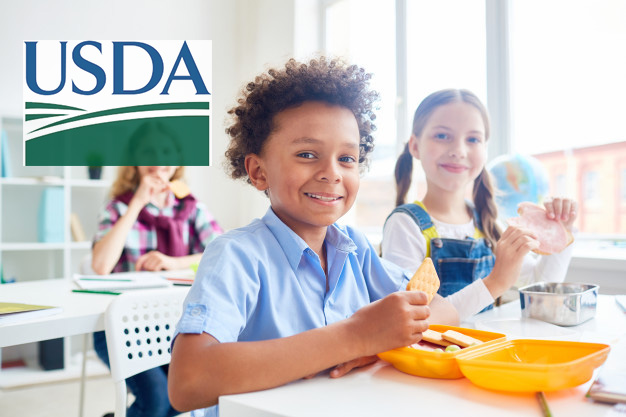
Parents and caregivers will soon begin the familiar routine of preparing and packing school lunches for their children. Parents and caregivers play a crucial role in safeguarding their children’s health by ensuring these lunches are safe from foodborne illness and allergens for those with food allergies. The U.S. Department of Agriculture’s (USDA) Food Safety and Inspection Service encourages you to follow these food safety tips and be allergen aware for a wholesome, worry-free return to the classroom.
“Children are particularly vulnerable to foodborne illness as their immune systems are still developing and they have limited ability to combat infections. This susceptibility is made worse by the increasing prevalence of food allergies that affect one in 13 children, or about two students per classroom,” said Under Secretary for Food Safety Dr. Emilio Esteban. “It is vital that parents and caregivers practice the four safe food handling steps when preparing and packing school lunches, as well as understanding how to identify food allergens.”
Food Safety Honor Roll Tips
Safe and wholesome school lunches begin with four simple safe food handling practices that everyone should always follow to avoid foodborne illness and minimize the risk of cross-contact with food allergens.
- Cleanliness is key. Wash your hands with soap and water for at least 20 seconds before, during and after handling food. Clean countertops with hot, soapy water, then sanitize with a commercial or homemade solution. An easy homemade sanitizer can be made by mixing one tablespoon of unscented, liquid chlorine bleach in one gallon of water. Let the solution stand on the surfaces for a few minutes; then air dry or pat dry with clean paper towels. This will ensure that harmful bacteria don’t cross-contaminate other foods and that food allergens are not transferred to a food meant to be allergen free.
- Separate foods. Keep raw meat, poultry and foods with allergens separate from ready-to-eat foods like fruits and vegetables by using different cutting boards and utensils. If possible, prepare items without allergens first to prevent cross-contact.
- Cook meats to a safe minimum internal temperature as measured with a food thermometer. Cooking to safe minimum internal temperatures is the only way to ensure the food is safe to consume. Never rely just on the color.
- Refrigerate foods promptly. Bacteria grow most rapidly in the range of temperatures between 40 F and 140 F, doubling in number in as little as 20 minutes. This range of temperatures is often called the Danger Zone. When packing your child’s school lunch in an insulated soft-sided lunch bag, it is important that you keep cold foods cold (at 40 F or less) by adding two frozen gel packs (not smaller than 5×3 inches each) or combine a frozen gel pack with a frozen juice box or frozen bottle of water. If you will be packing hot lunches, use an insulated container to keep food like soup, chili and stew hot. Keep the insulated container closed until lunchtime to keep the food hot — 140 F or above.
To learn more about how to properly pack a school lunch, visit Keeping Bag Lunches Safe.
The “Big 9” Food Allergens
The nine leading causes of food allergies identified in the U.S. are milk, eggs, fish, shellfish, tree nuts, peanuts, wheat, soybeans and sesame. These allergens are required to be listed on a food label when present.
The best prevention of an allergic reaction is the strict avoidance of food allergens. Consider these tips for managing foods with potential allergens:
- Always read ingredient label statements thoroughly, even if you are familiar with the product or have bought it before. If a food product does not have an ingredient label, it is safest to avoid consuming it.
- Prepare items without allergens first to prevent cross-contamination.
- If your child has food allergies, teach them which foods they should avoid and what they look like.
- Educate your child about the importance of washing their hands before eating, not sharing food with friends and the rules of allergen-safe zones if their school has one.
- Clearly label your child’s lunchbox, food items, or containers with their name and allergen information to alert others of their dietary restrictions.
To learn more about food allergens, visit Food Allergies: The “Big 9.”
If you have food safety questions, call the USDA Meat and Poultry Hotline at 1-888-MPHotline (1-888-674-6854), email MPHotline@usda.gov or chat live at www.ask.usda.gov 10 a.m. to 6 p.m. Eastern Time, Monday through Friday. Available in English and Spanish.
USDA


Chattooga Opinions
The Joy of the Journey: Offering Our First Fruits

Bulloch Public Safety
Georgia Southern chooses seasoned law enforcement officer Trey Drawdy as Chief of Police

Georgia Lifestyle
Georgia’s Food Shrimp Season Extended Until Jan 17

Crime & Safety
GBI Investigates Death in Macon County

Bulloch Public Safety
12/23/2024 Booking Report for Bulloch County

Bulloch Public Safety
12/09/2024 Booking Report for Bulloch County

Bulloch Public Safety
12/16/2024 Booking Report for Bulloch County

Bulloch Public Safety
01/02/2025 Booking Report for Bulloch County

Bulloch Public Safety
12/12/2024 Booking Report for Bulloch County




